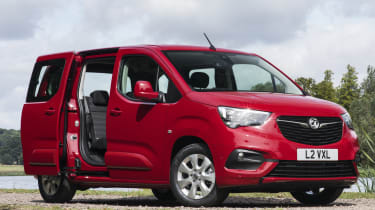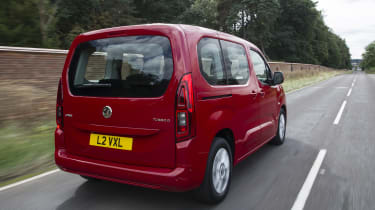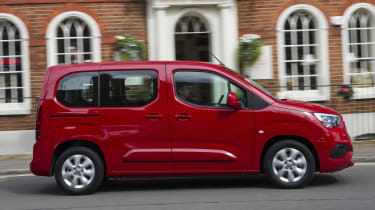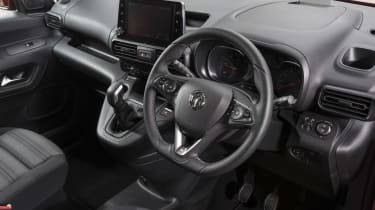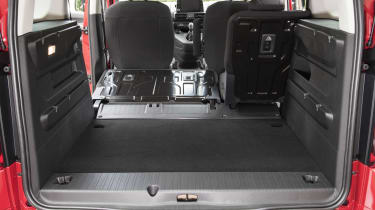The Vauxhall Combo Life is unashamedly an MPV, delivering practical, flexible and cost-effective family transport
3.5 out of 5
Price£21,155 to £29,205
- Space
- Versatility
- Low running costs
- Van-like styling
- Uninspiring interior
- Lacklustre dynamics
Best people carriers and MPVs 2021
- Berlingo vs Combo Life vs Tourneo
- Vauxhall Combo van review
- Vauxhall Combo van (2012-2018) review
- New Vauxhall Combo Life 2018 review
The driving experience is relaxed, smooth and comfortable, with the diesels providing the best performance Few people will be expecting to read about an MPV that’s fun to drive and fizzing with excitement. So in this respect, the Vauxhall Combo Life doesn’t disappoint. With van-like dimensions, a tall stance and a range of economy-led engines, this isn’t a vehicle that has been engineered to delight.
Which is rather refreshing. Keep the Combo Life within its comfort zone and it’ll repay you with a smooth ride and relaxed manners – two attributes that are particularly prominent when driving long distances and on the motorway. It’s a shame that a high level of wind noise tends to blot the Combo Life’s copybook when driving at motorway speeds.
Aside from that, the engines drop to a relaxed hush at speed, with the automatic transmission suiting the Combo Life’s laid-back approach. Indeed, the auto would be our choice, because the Stellantis-sourced manual gearboxes are vague and unsatisfying.
19
Predictably, there’s a fair amount of lean if you drive with gusto, while the car’s tendency to understeer means that you’re unlikely to push the Combo Life hard into a corner more than once.
Engines, 0-60 acceleration and top speed
All engines are sourced from Stellantis and each one has been configured to deliver good economy and low CO2 emissions rather than rapid acceleration and top speed. Which means that no model offers a 0-62mph time of less than 12 seconds.
The quickest off the line is the auto-only 128bhp 1.2-litre petrol, which manages 0-62mph in 12.3 seconds before reaching a top speed of 115mph. The 108bhp engine is slower still, taking between 13 and 13.9 seconds to get from 0-62mph and having a 108mph top speed.
In the 99bhp diesel versions, you can expect to hit 0-62mph in just under 13 seconds, with a top speed of 107mph. Predictably, the long-wheelbase XL is heavier and a little more sluggish.
In reality, these figures are largely irrelevant. More importantly, the additional torque offered by the diesel versions – 250Nm in 99bhp guise versus 205 and 230Nm for the petrols – makes lighter work of carrying a full quota of passengers and their luggage.
MPG, CO2 and Running Costs
Strong economy figures, low CO2 emissions and cheap insurance deliver low running costs With commonly used engines, the Vauxhall Combo Life is always going to deliver strong fuel economy, even if the claimed figures look a little less impressive in the WLTP era of economy and emissions testing.
The 1.5 Turbo D BlueInjection diesel is the economy hero, officially returning 53.3mpg. A now-discontinued 128bhp diesel was similarly economical, but now only the 99bhp diesel remains.
A 1.2-litre PureTech petrol engine is also available, offering 108bhp for manual-equipped cars and 128bhp for those with an automatic gearbox. Up to 44.1mpg is achievable in the former, with the latter dropping slightly to around the 40mpg mark.
These figures are lower than the old NEDC figures, but are more representative of real-world driving, so they should be closer to what you can achieve in reality. Also, there’s no economy penalty for choosing a seven-seat or XL version of the Combo Life, even if performance is slightly blunted.
19
With CO2 emissions creeping under 110g/km for the diesel engine, you’ll pay £220 for the first-year VED (road tax) followed by the standard yearly rate from year two. In the petrol versions, the first-year rate increases sharply to £555, followed by the same flat rate of VED. Fortunately, you probably won’t notice the petrol’s first-year VED cost as it’s usually wrapped up in the on-the-road price.
Insurance groups
The Combo Life falls into insurance groups 8 to 12, which means it will be cheap to insure, regardless of the engine size or trim level. It will also be cheaper than the Peugeot Rifter (groups 8 to 14) and Citroen Berlingo (groups 8 to 14).
For comparison, top-spec Volkswagen Caddy Life models slot into group 19.
Depreciation
According to our residual value experts, the Vauxhall Combo Life is a far more desirable product than its Peugeot or Citroen counterparts. While the Rifter has residuals in the region of 42-47 per cent, and the Berlingo is pegged back to a disappointing 32-39 per cent, values for the Combo Life are in the 48-54 per cent region. That’s rather strange when you consider that all three cars are virtually identical, aside from the design of their noses and cockpits. It clearly demonstrates that the Vauxhall badge is a more desirable choice than either Citroen or Peugeot.
Interior, design and technology
Plain looks and an uninspiring cabin are two of the Combo Life’s weakest areas You’d struggle to call any of the MPV trio from Peugeot, Citroen and Vauxhall attractive, but it’s arguable that the Combo Life has been dealt the weakest hand in the styling department. Little has been done to disguise the van roots, and the standard Vauxhall grille makes the Combo Life look, at best, rather plain, especially when compared with the rugged looking Rifter.
The Peugeot looks marginally more premium, while the Berlingo looks part of the Citroen family, thanks in part to the ‘Airbump’ panels on its exterior. Whether the Vauxhall’s ‘runt of the litter’ styling will matter to the target audience remains to be seen.
The same theme continues on the inside, because while the cabin is functional and fit-for-purpose, it lacks flair and imagination. Again, the Rifter has the most eye-catching cabin, thanks in part to the i-Cockpit layout with the dials above the small steering wheel. In the Combo Life, you get a layout that’s similar to the Citroen Berlingo, with the dials behind a conventionally sized steering wheel. Some buyers might prefer this more traditional look.
The dashboard area consists of a sea of grey plastics and hard surfaces. It’s neither easy on the eye or inspiring, which is perhaps why so many people prefer the more car-like ambience of an SUV. At least the main touch points are similar to those found in the rest of the Vauxhall range. The steering wheel, gearlever and column stalks are the same as you’ll find in an Astra or Grandland X, and help differentiate the Combo Life from the Berlingo, although you’ll only really notice the difference if you try both models back-to-back.
19
Some drivers will like the raised gear lever – we just wish the knob itself was nicer to use and not as chunky. The seats seem to have been designed with short journeys and cabin flexibility in mind, as they offer little in the way of support or comfort. Leather isn’t an option.
In fact, there’s little scope to add much in the way of luxuries, so we’d highly recommend the winter pack. Just £200 for a heated leather-covered steering wheel and heated seats seems like a small price to pay for a bit more comfort.
Sat-nav, stereo and infotainment
Somewhat surprisingly, all Combo Life models now come with a touchscreen that features Apple CarPlay and Android Auto, along with DAB digital radio, Bluetooth, USB audio connection and six speakers.
Upgrading to Vauxhall’s Multimedia Navi Pro system brings a sat nav system with 3D view and European mapping, plus the Connect system that adds emergency assistance, live traffic and online features. It’s standard on Elite and electric SE models, and optional elsewhere.
Practicality, comfort and boot space
The Combo Life offers a huge amount of space and flexibility, especially in XL or seven-seat guise Space and practicality are the main focus points of cars such as the Vauxhall Combo Life, and fortunately it doesn’t disappoint. Whether you opt for the 4.4-metre standard version or the 4.75-metre long Combo Life XL, you’ll find an enormous amount of space for passengers and their luggage inside.
You can opt for five or seven seats, regardless of the model, and sliding rear doors are standard fit across the range. Curiously, the Combo Life isn’t quite as slick inside as the Peugeot Rifter, with many of the clever touches found in the French version relegated to the options list in the Vauxhall.
For example, for the aircraft-style overhead storage compartments above the rear seats, you have to opt for the full-length panoramic glass sunroof – which costs around £850 extra. And it’s not available on XL or seven-seat models.
But in many ways, the Combo Life has the edge over many SUVs of a similar price – particularly from a practicality point of view. You get the same high driving position, but this is coupled with a huge glass area to provide excellent visibility.
Size
The standard Combo Life measures 4,403mm in length, while the Combo Life XL is 4,753mm long, with the extra length found behind the third row of seats.
19
This means you get a huge amount of boot space, which we’ll come to in a moment. All models are 2,107mm wide including door mirrors, or 1,921mm without. The standard Combo Life sits 1,841mm tall, with the XL version adding a further 39mm to the height.
For comparison, the Volkswagen Caddy Life is 4,408mm long and 2,065mm wide (with mirrors).
Leg room, head room & passenger space
Each seat offers plenty of space, with the light and airy cabin serving to accentuate the sense of roominess. On the five-seat models, the second-row seats split 60/40, while the seven-seat version allows them to be folded individually, delivering even more flexibility.
On the seven-seat XL, the third row of seats can be removed to create a cavernous load area. Each seat on the second row is Isofix-equipped, allowing for the fitment of three child seats.
Boot
The size of the boot is impressive, regardless of the model in question. In standard guise, there’s 597 litres of luggage capacity, which extends to 2,126 litres with the passenger seats folded down.
In the Combo Life XL, this extends a minimum of 850 litres, with a huge 2,693 litres available with all seats folded away or removed.
Towing
The braked towing capacity ranges from 1,110kg to 1,500kg depending on the engine, although the diesel motors can pull more than their petrol equivalents. A tow bar is around £500, and a trailer stability programme is integrated into the ESP system.
Reliability and Safety
Safety credentials are pretty good, while Vauxhall tends to perform poorly in reliability surveys Vauxhall doesn’t tend to fare too well in our Driver Power customer satisfaction surveys. In our last three surveys, the brand was ranked second from bottom on the list of the best and worst car manufacturers. Only Dacia has finished lower in the last couple of years.
Things are yet to improve under the ownership of Stellantis, although the Combo Life benefits from strong commercial vehicle underpinnings from Peugeot and Citroen.
The Combo Life has received a four-star Euro NCAP crash test rating courtesy of the Peugeot Rifter. It scored a solid 91 per cent for adult occupant safety and 81 per cent for child occupant safety, but the scores for vulnerable road users and safety assist tech were less polished at 58 per cent and 68 per cent respectively.
19
This is largely down to the Combo Life’s commercial roots, as it lacks some of the driver-assistance features we’ve come to expect in more conventional family cars. On the plus side, autonomous emergency braking and lane-keeping assistance are fitted as standard.
Rear parking sensors are also standard – handy given the Combo Life’s size – while Elite trim adds front ones and blind-spot monitoring. Automatic parking assist, a head-up display and automatic lights and wipers are an option on this trim. IntelliGrip switchable traction control that also adds all-weather tyres is a £410 option on SE versions.
Warranty
Every new Vauxhall comes with a three-year/60,000-mile warranty. Extended warranties are available, covering all major mechanical and electrical components, as long as the vehicle is under eight years’ old and has covered less than 80,000 miles when the warranty is purchased. The battery on Combo-e Life models is covered if it drops below 70% capacity in the first eight years or 100,000 miles.
Servicing
The Combo Life will require a service every 12 months or 20,000 miles, whichever comes first. Owners can spread the cost of servicing by paying for the Vauxhall Service Club, which, amongst other things, offers 15 per cent off accessories, half price MOTs, fixed price AdBlue refills, and a discount of up to 25 per cent on servicing and repairs.
Next Steps
New car deals
Which Is Best
Cheapest
Cheapest vehicles
Our 'cheapest' pick is the model with the lowest on the road retail price.Close
- Name1.5 Turbo D Design 5dr
- Gearbox typeManual
- Price£21,155
- Name1.5 Turbo D Design 5dr
- Gearbox typeManual
- Price£21,155
- Name1.5 Turbo D Design 5dr
- Gearbox typeManual
- Price£21,155
Most Economical
Most economical vehicles
Our 'most economical' pick is the model with the best fuel economy on the WLTP combined cycle.Close
Fastest
Fastest vehicles
Our 'fastest' pick is the model with the fastest time for the 0-62mph or 0-60mph sprint.Close
Source: Read Full Article
The Vauxhall Combo Life is a van-based people carrier that comes in five and seven seater configurations. It’s essentially the replacement for the now discontinued Vauxhall Zafira, and is the third model in a parts-sharing exercise with the Peugeot Rifter and Citroen Berlingo. It’s also the first time in recent history that Vauxhall has offered a functionality-led MPV.
Vauxhall is hoping that the Combo Life will appeal to an audience who aren’t wooed by the Crossland X or Grandland X SUVs, and it trades on the amount of space it offers. Fundamentally, the Combo Life is the same car as the Rifter and Berlingo, but is distinguished by different styling for the nose, a mildly reworked dashboard area and trim levels that are in line with the rest of the Vauxhall range.
You can order the Combo Life in standard and XL lengths, and each one is available in five- or seven-seat configuration. In standard form, the boot offers between 597 litres and 2,126 litres of luggage capacity, but this extends to between 850 litres and 2,693 litres in the long-wheelbase Combo Life XL.
All engines are sourced from the Stellantis group, with the range comprising a 1.2-litre turbocharged petrol motor and a 1.5-litre turbodiesel engine with a choice of two power outputs. A six-speed manual gearbox is standard on the petrol and higher-powered diesel, with a five-speed manual fitted to the lower powered diesel. An eight-speed automatic transmission is available as an option on the most powerful diesel.
More reviews
Car group tests
In-depth reviews
Road tests
In 2021 a fully electric version was launched. Called the Vauxhall Combo-e Life, it uses the same 50kWh battery as the Vauxhall Corsa-e and manages up to 174 miles on a charge. Like the standard Combo Life, it’s available with five or seven seats, although with just the one trim level, SE.
On petrol and diesel versions, SE is the middle of three trim levels available, with the Edition available from under £23,000 and the better-equipped Elite starting at about £28,000. Edition includes rear parking sensors, twin sliding doors and digital radio; SE adds alloy wheels, a reversing camera, an opening rear window and auto high-beam assist. Elite is the only model to get roof rails, sat nav and two-zone air conditioning as standard.
There isn’t a long list of options to choose from – this remains a resolutely practical and fuss-free MPV. However, it is possible to add the likes of a full-length panoramic glass sunroof and an all-weather pack, which offers selectable traction control that allows you to tailor the system to suit the driving conditions. It’s the closest you can get to a four-wheel drive Combo Life (a 4WD Combo van is available for business buyers).
Vauxhall has done little to disguise the Combo Life’s van-based roots, which for some buyers will make a welcome change from the over-styled and overly-complex SUVs of the world. It’s for this reason that Vauxhall might steal sales from the SUV-styled Peugeot Rifter. Other rivals include the Berlingo, Ford Tourneo Connect, Volkswagen Caddy Life and the ageing Fiat Doblo, which was also sold as the previous generation Vauxhall Combo.
It would be easy to dismiss the Vauxhall Combo Life as the third model in the platform-sharing venture that has also given us the Peugeot Rifter and Citroen Berlingo – the French duo look more attractive, while the Rifter offers a far more interesting cabin. But look beyond the humdrum styling and you’ll find a refreshingly honest MPV, offering a huge amount of space for up to seven people and a number of seat configurations that boost practicality. The driving experience is predictably van-like, but the Combo Life appears to have been pitched perfectly for those who want to get from A to B and aren’t too fussed about what happens in between.

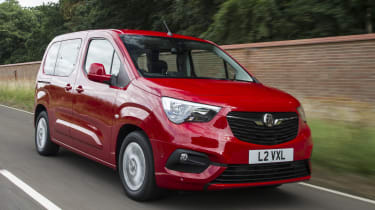
 Best people carriers and MPVs 2021
Best people carriers and MPVs 2021